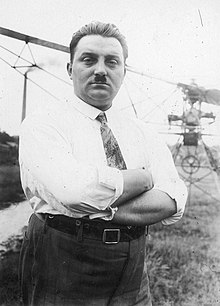Orionette (motorcycle)
| Orionette AG for motor vehicles
|
|
|---|---|
| legal form | Corporation |
| founding | 1921 |
| resolution | 1925 |
| Seat | Berlin ; Industriehof Oranienstrasse 6 |
| Branch | Automotive and motorcycle industries |
Orionette is a historic German motorcycle brand.
The German Orionette , as the motorcycle was also called, was manufactured between 1921 and 1925 by Orion Aktiengesellschaft für Motorfahrzeuge in Berlin - Kreuzberg . The company is also known as Orionette AG for motor vehicles . The chief designer was the engineer Engelbert Zaschka .
Company and history
The first Orionette motorcycle hit the market in 1921. How big the production really was can no longer be said. The brand name Orionette was not only known in Berlin . The Orion corporation for motor vehicles was one of the most important companies in Berlin for cars and motorcycles of the 1920s.
The complex Industriehof Oranienstrasse house number 6 in Berlin-Kreuzberg , which is now a listed building , was the company location of Orionette AG for motor vehicles and the place of manufacture of the Orionette in the 1920s and 1930s .
The company built a range of 129 cm³, 137 cm³, 148 cm³ and 346 cm³ two-stroke engines with mainly uniformly designed engines and two- or three-speed transmissions. The construction department, under the direction of Engelbert Zaschka , also produced some interesting unusual constructions. Among them were combined two-stroke engines and a four-stroke engine with a valve in the crankcase . However, only a few of these two-stroke engines were actually built. Zaschka was able to realize his own construction, which was ultimately also manufactured in series .
Zaschka system

The Orionette two-stroke engine was also called the Zaschka system . The name goes back to Engelbert Zaschka , who developed and constructed the motor system for the Orionette .
The two-stroke engine consists of an uncontrolled poppet valve for the inlet in the crankcase (works like an automatic diaphragm control). Another component is the crank pre-compression chamber. This is followed by four overflow channels arranged around the piston , which are controlled in the usual way by the upper edge of the piston. The cylinder chamber and the exhaust valve, which is controlled by a rocker arm and a bumper and hanging in the head, are also connected to one another. The desmodromic control is operated by means of two cams (with crankshaft speed). One to open, the other to close the valve. Characteristic of the Berlin engine were the spark plug screwed in horizontally from the front on top of the cylinder and the decompression valve on the rear.
literature
- Carl Walther Vogelsang: Leicht-Motorräder Vol. 8. CJE Volckmann Nachf. E. Wette, Berlin-Charlottenburg 1923.
- Walther Häntzschel-Clairmont: The motor vehicles and their treatment. Walter Killinger Verlag, Nordhausen 1925.
- Rudolf Franke: Auxiliary book for the automobile workshop. Heinrich Killinger Verlag, Nordhausen 1928.
- Rudolf Hiller: The development of the two-stroke motorcycle. VEB Verlag Technik, Berlin, 1st edition 1963.
- Karl Reese: Motorcycles from Berlin. Motorcycle stronghold in the beginning. Johann Kleine Vennekate Verlag, Lemgo 2002, ISBN 3-935517-05-X .
Web links
- ORIONETTE, MOTORETTE - GTÜ - classic car service
- Illustration of the "Orionette" motorcycle & basic sketch of the "Zaschka system"
- Motorcycle magic - Orionette Type 2: 1945 hidden in the hay from the Russians - ADAC
photos
- Picture with driver - Motorcycle-Memories.com
- Prototype: Orionette TS 350 cm³ 2 (1925) - ozebook.com
References and comments
- ↑ gtue-oldtimerservice.de: ORIONETTE, MOTORETTE , accessed on May 13, 2008.
- ↑ Otto Meibes: The development of the German automotive industry. Hall 1926, page 166.
- ^ Karl Reese: Motorbikes from Berlin. Motorcycle stronghold in the beginning. Johann Kleine Vennekate Verlag, Lemgo 2002, page 103.
- ^ Stefan Knittel: Berlin School. Orionette (1922). In: Motorrad Classic , issue 2/1994.
- ↑ See Kurt Doogs: The Berlin machine industry and their production conditions since their emergence , Diss. TH, Berlin 1928, page 78.
- ↑ This is where Konrad Zuse , the inventor of the computer, completed the first program-controlled and freely programmable computer in 1941 . This first computer Z3 was completed in May 1941 in Berlin-Kreuzberger Oranienstrasse 6 (as Wilhelm Mons in the description of Zuse's career)